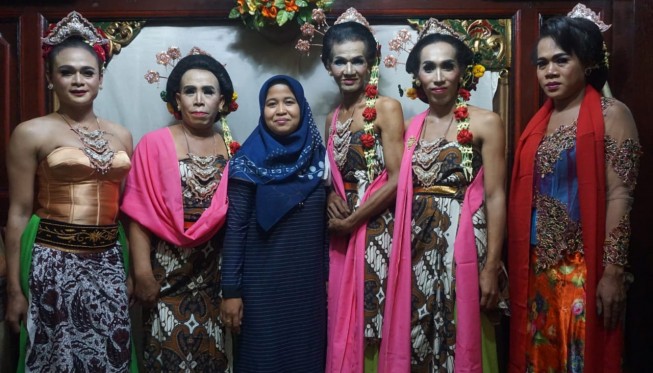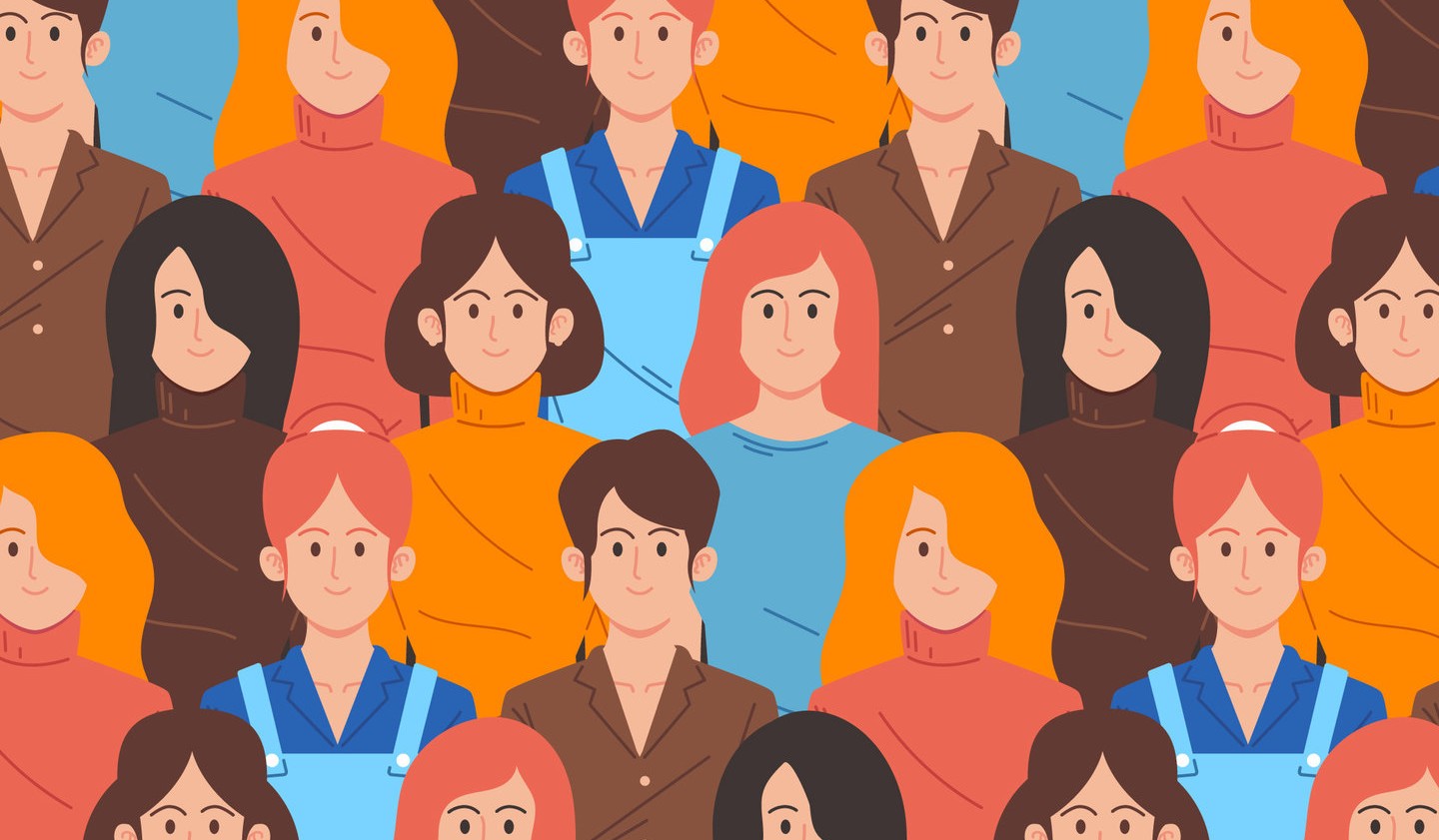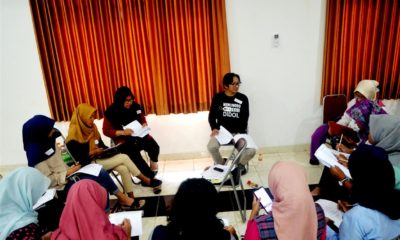News
Waria Prostitution is Because of Heterosexual Men
Published
4 years agoon
By
Mitra Wacana
By : Masthuriyah Sa’dan (Researcher and Member of Fatayat NU DIY)
The weekend of July 2019, on a cold night in the city of Yogyakarta, I was with Maria Sattwika, a master student at the International Institute of Social Studies at Erasmus University Rotterdam in the Netherlands, enjoying a glass of hot tea with a transgender friend.
Waria (transgender women) communities, both Muslim and non-Muslim, in Yogyakarta are some of my friends. With them, my life is more colorful. Because their presence enriches my perspective and paradigm of thinking about social relations and human diversity; that there are women, men, and there those in between the two. The conversation becomes more heated when the waria share their life experiences in terms of sexual activity, work, and life necessities.
A waria friend said, “Waria prostitutes exist because there are heterosexual men who enjoy our bodies, but why do we only blame waria?” That question made me speechless. I tried to think and ask myself why, in the case of waria prostitution, only waria get stigma, marginalization, and persecution? While they that are heterosexual men are in a safe position. It is as if the error is rooted in waria personally, without looking at cause and effect; that waria prostitution is a result, caused by heterosexual men.
Without generalizing that waria are Commercial Sex Workers (CSWs), this paper documents and shares experiences of waria friends as CSWs. The purpose of this paper is to change the perspective of the majority of the community so that it is fair to think and see that the issue of waria prostitution does not stand alone, it exists because heteroxual men are a factor (one of them).
Get to Know Gayatri
Gayatri is the name of my waria friend (pseudonym). She was born in Bone, South Sulawesi. Born into a family of farmers and devout Muslims. Gayatri is the first child of seven siblings. As the first child, since childhood Gayatri often carried and played with her younger siblings. Gayatri does what her mother does, from caring for young children, cooking, washing clothes, washing dishes, cleaning the house, to helping farming in the fields.
According to Gayatri, Gayatri’s mother had unconsciously treated Gayatri as a woman even though she was born the male sex. Living and family conditions require Gayatri to do “all” domestic work that is socially and culturally associated as women’s work. Economically, Gayatri’s family is poor. The last of Gayatri’s education was Elementary School (SD). After the age of 12 years, Gayatri felt that she was not a man. In the process of wandering, with capital can read and write, and ends up in the city of Yogyakarta.
Life in the city is not as easy as many people imagine. For Gayatri, Yogyakarta City is a place to create a better life and at the same time a space to show gender expression. The effort to realize that direction, for Gayatri, is full of struggle. Life demands that she eat and pay boarding, requiring Gayatri to do something that can make money. With the basic makeup and body shape that “resembles” a woman, Gayatri busks in the corners of the city of Yogyakarta, starting from Beringharjo Market, Malioboro sidewalks, red lights, small cafes, until becoming a sex worker.
Gayatri’s Stories of Becoming a Sex Worker
Within a day, Gayatri gets from money from busking of 50,000 rupiah to infinity. The size of the income from busking, according to Gayatri, depends on luck. If you’re lucky, you get lots of money; if a little, yes, just enough to eat for a day and for cigarettes. As she gets older, Gayatri realizes that her life needs are increasing. Starting from the cost of meals, a kos (small living space), body care, pulsa (credit), to health costs. The urgency of these needs “demands” Gayatri, with full awareness, to cut corners, namely minimal work but maximum income.
The only job that promises a lot of money, according to Gayatri, is only work in the “Esek-Esek” sector, namely the night world. Sex work does not require having a recent education diploma, skills, experience, gender requirements, and other requests that are not “owned” by waria such as Gayatri. According to Gayatri, waria sex worker’s customers are heterosexual men. They come from various groups, ranging from high school students, college students, ojek (motorcycle taxi) drivers, pedicab drivers, street vendors, businessmen, to state officials.
The reason heterosexual men use sex services from waria is due to various unique factors. There are those who want to experiment, to try sex with waria, who want another sexual sensation, as an outlet for sex because they are “bored” with their wives, want to “snack” at low prices, and other reasons. Gayatri recognizes that waria sex worker’s rates vary, depending on the economic conditions of customers. If the customers are middle to lower class economic men and even below, then the price for sex is between 100,000-200,000 rupiah.
If the customers are upper-middle class male, then the price can go up; it depends on the agreement between the waria sex worker and the customer. In Gayatri’s experience, in one night she can get 1-3 male customers. Having a few or many customers again depends on the factor of luck. Gayatri promotes herself as a waria sex worker through social media, namely Facebook, Instagram, and WeChat, and continues personal communication on WhatsApp . The brand used by Gayatri is “Plus-Plus Massage Services”.
Social media is the only promotional media Gayatri uses to get customers. On social media, Gayatri publishes a photo of herself with maximum style, to make herself appear rich/flashy/fierce, using clothes such as tank tops and skirts or pants above the knee. Gayatri’s photo display that impresses with her beauty is also supported by a sophisticated HP camera, for which of course the price is not cheap. Gayatri’s friends on social media who comment on the photos are heterosexual men. Gayatri’s photos are the main attraction to get as many “buyers” as possible.
The transaction process starts through messages in Facebook Inbox, Direct Message (DM) on Instagram, or messages on WeChat, and then they arrange transactions and meetings on WhatsApp. After it was agreed where to meet, then Gayatri and the customers met; paid according to the agreed price, and have sex / a one night stand.
The places used by Gayatri are Melati class hotels in the area surrounding Yogyakarta City, while the service of using hotel rooms is borne by the customer. That is, Gayatri only accepts sex fees, while men cover sex services and hotel accommodations. The age of Gayatri is no longer “young”, but now 56 years old. Gayatri no longer receives the sex services as before when she was young. In addition to because of her age, it is also because of health factors. So, according to Gayatri’s confession, in a month she is “strong” in getting 5-10 male customers.
Why Are Waria Prostitutes Blamed?
The experience of Gayatri working as a prostitute was also experienced by many other waria friends. The economic demands for life and food “force” waria friends to do something to simply survive. The last diploma of Gayatri which did not sell in the capitalist labor market economy, then the rejection of family, society, environment, and religion, made the problems of Gayatri’s life increasingly complex. Though the demands of individual life continue on.
When Gayatri and other waria only have one choice of employment, namely as a sex worker, where the work is percieved by the majority of the community as a “social anomaly”, then that’s where the stigma is attached to waria. Almost as if waria prostitution exists because of waria themselves. Even though waria will not become sex workers when their families, communities and government provide access to positive work for them. But in fact, in almost all lines of work that are considered “cool” by the community, waria are eliminated.
In addition, waria sex workers’ customers are heterosexual men. The living conditions of waria sex workers with their demands, plus the demands of heterosexual male sex, this is what is “suspected” of perpetuating waria prostitution. That is why waria prostitution flourishes, because it goes hand in hand with heterosexual men’s sexual needs. To paraphrase Gayatri’s question, if heterosexual men cannot limit their lusts, why are waria sex workers being blamed?
At the end of this article, I will quote Prof. Nur Syam (Professor of Sociology at UIN Sunan Ampel Surabaya) in the book “The Concept of God in the Perspective of Prostitutes” (2016) that the world of prostitution is an institution needed by the community and a place that attracts men to approach it. Therefore, the world of prostitution will continue to exist because there is always a need.
This article has been published in https://www.qureta.com/post/prostitusi-waria-ada-karena-laki-laki-heteroseksual
You may like
News
Are American and Indonesian Women Really So Different?
Published
4 years agoon
7 February 2020By
Mitra Wacana
by Jacqueline Lydon – Volunteer internship Program Mitra Wacana
After growing up in the U.S., now living in Indonesia for about five months and interning at Mitra Wacana for three, I’ve been surprised at the similarities between conditions for women in the two countries.
On the surface level, women in the U.S. and Indonesia may seem like polar opposites.
When comparing the two, people tend to focus on the behaviors and appearances of women. Women are judged for how they dress, how they act, and how independent they are, for example.
Americans might judge Indonesian women for dressing conservatively, staying in the domestic sphere, and being seemingly submissive to their husbands. Meanwhile, Indonesians might judge American women for not covering their bodies, being too sexual, not focusing on domestic roles, or being too loud and demanding.
What I’ve noticed since being here is first, that these differences are less noticeable than I had thought, and second, that they seem to stem from differences in cultures and societal norms. There are different ways of understanding gender and gender roles, yet women in both America and Indonesia want safety, respect, and to have a voice.
There are many similarities between women’s behaviors and struggles in the two countries.
- 51.9% of Indonesian women are in the workforce, compared to 57.1% of U.S. women
- 17.4% of the Indonesian parliament is female, compared to 23.9% of the U.S. legislature
- The first Indonesian woman was elected president in 2001, while a woman has never yet been president in the U.S.
- The first female supreme court justice in Indonesia, Sri Widoyati Wiratmo Soekito, was inaugurated in 1968, while the first woman to join the U.S. supreme court was Sandra Day O’Connor in 1981, about 15 years later.
There are many issues – from sexual harassment to rape – that have a widespread impact on women in both countries, but it’s hard to have accurate statistics because many women do not or can not report these incidents. But based on what is reported, it’s clear that these are major issues in both countries.
- 3 out of 5 Indonesian woman and 81% of American women have experienced sexual harassment
- 15% of Indonesian women and more than 1 in 3 American women report being a victim of sexual violence
- 16% of Indonesan women and about 25% of women in the U.S. have reported being a victim of intimate partner violence (physical, sexual, or psychological violence from a partner or spouse)
With two countries in which women’s attitudes and behaviors seem so different, it’s surprising how similar women’s successes and struggles are.
Just last year, a poll in the U.S. found that only 29% of American women identify as feminists. (Feminist: someone who believes men and women should have equal rights.) In both countries, there are both feminist movements and anti-feminist movements (In the U.S., “meninism”; in Indonesia, “Indonesia tanpa feminisme”). In both, women’s voices are suppressed; women who advocate for themselves are often seen as too demanding, and their problems are ignored.
Why is there so much judgement for women’s choices in both countries?
Part of this is based on stereotypes, which are continually built up about women who act differently. Women in each country are taught that their culture’s roles, behaviors, and values are the better choice, and if only they stick to that, they will avoid the problems faced by women in different cultures. For example, women in the U.S. are taught that being more assertive will help them achieve more political representation, and women in Indonesia are taught that behaving modestly will help them avoid sexual violence or harassment. Yet the similarities in statistics prove that it is not the behaviors of women that cause these problems, and neither culture’s prescriptions for women will solve the issues.
Of course, there is not one simple answer for these systemic issues. But, the main culprit of sexism around the globe is the patriarchy – the system that has been constructed to empower men and subjugate women. It is this system that has created this notion of victim blaming – to judge and blame women for their own oppression instead of the overarching system.
Instead of looking at the choices of women or judging them, we should look at the system of patriarchy that is prevalent in both countries.
I think we need to stop focusing on the behavior of women and instead focus on the way that society judges and oppresses all women, and then build solidarity to break down those systems. The ideal of how a woman should be and should act may be different in both cultures, but it is universal that women should be free from violence and treated with dignity and respect.
Editor: Arif Sugeng W















